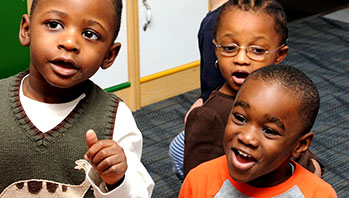- big
- small
MA Standards:
Speaking and Listening/SL.PK.MA.1a: Observe and use appropriate ways of interacting in a group (e.g. taking turns in talking, listening to peers, waiting to speak until another person is finished talking, asking questions and waiting for an answer, gaining the floor in appropriate ways).
Language/L.PK.MA.1.b: Use frequently occurring nouns and verbs.
Mathematics/Measurement and Data/PK.MD.MA.1: Recognize the attributes of length, area, weight, and capacity of everyday objects using appropriate vocabulary (e.g., long, short, tall heavy, lights, big, small, wide, narrow).
Head Start Outcomes:
Social Emotional Development/Self-Regulation: Follows simple rules, routines, and directions.
Language Development/Receptive Language: Attends to language during conversations, songs, stories, or other learning experiences.
PreK Learning Guidelines:
English Language Arts/Language 1: Observe and use appropriate ways of interacting in a group (taking turns in talking; listening to peers; waiting until someone is finished; asking questions and waiting for an answer; gaining the floor in appropriate ways).
English Language Arts/Reading and Literature 12: Listen to, recite, sing, and dramatize a variety of age-appropriate literature.
EEC Infant and Toddler Guidelines:
PW50.: The older toddler engages in a variety of physical activities.
Recite Together: “Big and Small”

© Commonwealth of Massachusetts, Department of Early Education and Care (Jennifer Waddell photographer). All rights reserved.
ELA Focus Skills: Compare and Contrast, Follow Directions, Gross Motor Skills, Phonological Awareness (Rhythm and Rhyme), Vocabulary
Remind children that the toy boat felt very small next to the other boats. Have children sit on the floor and roll up into a little ball. Ask them to become as big as a giant ferryboat or sloop. Then ask them to become as little as a tiny toy boat.
Recite the poem “Big and Small” and act it out. Invite children to recite with you and do the actions. Do this several times as a good stretching exercise.
Big and Small
I can make myself real big, (stand up on toes)
By standing up straight and tall.
But when I am tired of being big,
I can make myself get small. (stoop down)
English Language Learners: Model the movements for children and say the words big and small as you do. Have children repeat the words and movements.
